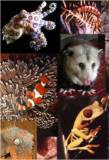1. The largest animal ever existed on earth is
 Learn more :
Learn more :
a) Woolly Mammoth2. Which class has the largest number of animals?
b) African elephant
c) Tyrannosaurus
d) Sulphur bottom (blue) Whale
a) Mammals
b) Fishes
c) Insects
d) Reptiles
3. Salamander belongs to the class:
a) Aves4.Vertebrates and tunicates share
b) Reptiles
c) Pisces
d) Amphibian
a) Jaws adapted for feeding5. The water vascular system of echinoderms
b) A high degree of cephalisation
c) A notochord and a dorsal, hollow nerve cord
d) The formation of structures from the neural crest
a) Functions as a circulatory system that distributes nutrients to body cells6. Acoelomates are characterized by
b) Functions in locomotion, feeding, and gas exchange
c) Is bilateral in organization, even through the adult animal is not bilateral symmetrical
d) Moves water through the animal body during suspension feeding
a) The absence of brain7. Which of the following characteristic is probably most responsible for the great diversification of insects on land?
b) The absence of mesoderm
c) A solid body without a cavity surrounding internal organs
d) A coelom that is not completely lined with mesoderm
a) Segmentation8. Mammals and living birds share all of the following characteristics except
b) Antennae
c) Bilateral symmetry
d) Exoskeleton
a) Endothermy9. Most marsupial and all monotreme species today, are found in:
b) Descent from a common amniotic ancestor
c) A dorsal, hollow nerve cord
d) An archosaur common ancestor
a) Australia10. Which of the following combination of phylum and description is incorrect?
b) Asia
c) Europe
d) Central and south America
a) Echinodermata-bilateral symmetry as larva, coelom present
b) Nematoda-roundworms, pseudocoelomate
c) Platyhelminthes- flatworms, gastrovascular cavity, acoelomate
d) Calcarea-gastrovascular cavity, coelom present
 Learn more :
Learn more :Answers:
1. d) Sulphur bottom (blue) Whale
2. c) Insects
3. d) Amphibian
4. c) A notochord and a dorsal, hollow nerve cord
5. b) Functions in locomotion, feeding, and gas exchange
6. c) A solid body without a cavity surrounding internal organs
7. d) Exoskeleton
8. d) An archosaur common ancestor
9. a) Australia
10. d) Calcarea-gastrovascular cavity, coelom present